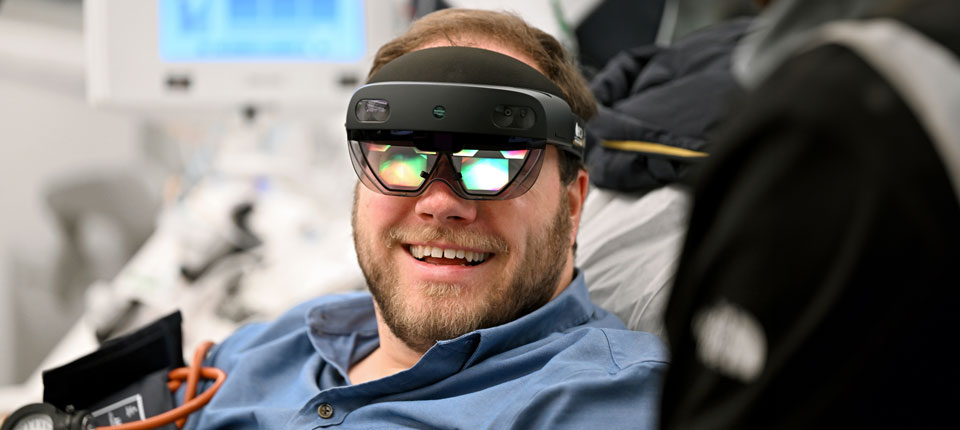For years, the narrative surrounding the future of personal computing has been dominated by the grand vision of spatial computing—a world of immersive, mixed-reality headsets that would blend our digital and physical environments. We were promised virtual desktops floating in our living rooms and holographic collaborations that would redefine work. Yet, a subtle but significant recalibration is underway in the world of wearables. The latest buzz in Smart Glasses News isn’t about bigger, more powerful headsets, but about a strategic pivot towards a more accessible, immediate, and intelligent form factor: AI-powered smart glasses. This shift marks a move away from “destination” computing, where you don a device for a specific immersive task, and towards “journey” computing—a persistent, ambient layer of AI assistance that enhances your daily life without pulling you out of it.
This emerging trend, a hot topic in Wearables News, suggests that the path to mass adoption may not be through creating alternate realities, but by seamlessly augmenting our own. Instead of focusing on computationally expensive, visually overwhelming augmented reality, the industry is increasingly prioritizing lightweight glasses that serve as an always-on AI Companion Device. These devices leverage the power of multimodal AI to see what you see, hear what you hear, and provide contextual, real-time assistance. It’s a pragmatic evolution, acknowledging that for a wearable to be truly worn, it must first and foremost be unobtrusive, stylish, and genuinely useful in everyday moments. The race is no longer just about who can build the most powerful portal to the metaverse, but who can create the most intelligent and integrated assistant for the real world.
The Great Pivot: From Spatial Computing to Ambient Intelligence
The journey towards the next wave of personal computing has been following two distinct, and increasingly divergent, paths. Understanding this split is crucial to interpreting the latest developments in AR/VR AI Gadgets News and the broader tech landscape. One path leads to total immersion, while the other champions subtle, intelligent augmentation.
The Promise and Pitfalls of High-End Mixed Reality
The vision of spatial computing, championed by powerful mixed-reality (MR) headsets, is undeniably compelling. These devices aim to create a new computing paradigm where digital objects have presence and persistence in our physical space. The applications are profound, ranging from surgeons overlaying patient data during an operation to engineers collaborating on a 3D model of a jet engine in real-time. Early iterations and ongoing AI Research / Prototypes News have demonstrated incredible potential in enterprise, design, and high-end entertainment.
However, this vision comes with significant hurdles that have so far limited its mainstream appeal. The primary obstacles include:
- Cost and Accessibility: High-end headsets often carry price tags in the thousands of dollars, placing them firmly in the realm of prosumers and enterprise clients rather than the average consumer. – Form Factor: Despite engineering marvels, these devices are still relatively bulky, heavy, and can cause discomfort during extended use. Their conspicuous nature also creates a high social barrier, making them impractical for use in public spaces.
- Battery Life: Powering multiple high-resolution displays, sensors, and processors is incredibly energy-intensive, leading to limited battery life that curtails the dream of all-day use.
- Niche Use Cases: For many people, the “killer app” for a fully immersive headset remains elusive for daily life, relegating them to specific tasks like gaming, media consumption, or specialized work.
The Rise of the AI Companion
In contrast, the emerging category of AI smart glasses takes a fundamentally different approach. The goal is not to overlay a complex digital world but to provide a subtle, intelligent assistant that operates at the speed of thought. This philosophy aligns closely with trends in AI Assistants News, where the focus is on creating proactive and context-aware support systems.
These devices prioritize a lightweight, conventional glasses form factor. Their primary interface is not a complex visual overlay but a combination of voice commands, subtle audio feedback, and perhaps a minimalist heads-up display for simple notifications. The “magic” lies in the onboard AI, which acts as a co-processor for your brain. It’s a device designed to integrate with your AI Phone & Mobile Devices News ecosystem, acting as a hands-free extension of your digital life. The core value proposition shifts from “what you can see” to “what you can know and do,” hands-free, in any given moment.
Technology Breakdown: What Powers the New Wave of Smart Glasses?

The pivot to AI-centric smart glasses is not just a change in philosophy; it’s enabled by significant advancements in several key technological areas. These devices are marvels of miniaturization, packing sophisticated processing, sensing, and connectivity into a frame that is both socially acceptable and comfortable for all-day wear.
On-Device AI and Edge Computing
A critical enabler for these new wearables is the progress in on-device processing. Relying solely on the cloud for AI tasks introduces latency, consumes significant power for data transmission, and raises major privacy concerns. The latest AI Edge Devices News highlights the development of highly efficient Neural Processing Units (NPUs) and Systems-on-a-Chip (SoCs) designed for low-power AI inference. By performing tasks like keyword spotting, basic object recognition, or real-time translation directly on the glasses, these devices can provide instant responses without needing a constant connection. This local processing is fundamental to making the glasses feel responsive and reliable, a key requirement for any true companion device.
Multimodal AI: Beyond Text and Voice
The true power of AI smart glasses lies in their ability to understand the world through multiple inputs simultaneously—a concept known as multimodal AI. They are not just listening for a wake word; they are constantly processing a stream of data from various sources:
- Vision: An integrated camera provides a real-time video feed. This is the cornerstone of AI-enabled Cameras & Vision News, allowing the AI to identify objects, read text, recognize faces, and understand the user’s environment.
- Audio: Multiple microphones capture the user’s voice commands as well as ambient sounds, enabling features like noise cancellation and situational awareness. Developments in AI Audio / Speakers News are leading to discreet, high-quality open-ear audio solutions.
- Sensors: Accelerometers and gyroscopes track head movements, providing crucial context for the AI. Future iterations could integrate data from other AI Sensors & IoT News, such as ambient light or even biometric sensors.
A multimodal AI model can fuse these inputs to derive rich, contextual understanding. For example, a user can look at a foreign menu, ask “What’s the most popular dish here?”, and the AI will use the camera to read the menu, its internal knowledge base to identify popular items, and the speaker to provide an answer. This is a far more intuitive and powerful interaction than pulling out a phone and opening multiple apps.
Miniaturization and Power Efficiency
The ultimate engineering challenge is cramming all this technology into a standard eyewear form factor. This involves breakthroughs in multiple domains. Display technology is shifting from large, immersive panels to micro-LED or waveguide projectors that can cast a small, non-intrusive image onto the lens for notifications or turn-by-turn directions. Battery technology remains the primary bottleneck, forcing a delicate balance between features and longevity. Many designs will likely adopt a hybrid approach, where the glasses handle low-power sensing and inference while offloading more complex computational tasks to a paired smartphone, preserving precious battery life for all-day operation.
Real-World Applications and Ecosystem Integration
The true measure of success for AI smart glasses will be their ability to seamlessly integrate into our daily routines and provide tangible value. Unlike their bulkier MR counterparts, their applications are not confined to specific tasks but are woven into the fabric of everyday life, turning the device into an indispensable part of a user’s personal technology ecosystem.
A Day in the Life with AI Smart Glasses
Imagine a typical day enhanced by an AI companion. You wake up, and as you put on your glasses, a subtle display shows the weather and your first appointment. While making coffee, you glance at the milk carton and ask, “Are we low on milk?” The glasses, connected to your Smart Home AI News ecosystem and smart fridge, add milk to your shopping list. During your commute, which might one day be in a vehicle guided by Autonomous Vehicles News, you receive navigation prompts directly in your line of sight. At the office, a key topic in AI Office Devices News, you can record meetings and get real-time transcriptions. While traveling, a feature highlighted in AI for Travel Gadgets News, you can look at any sign or menu and see an instant translation. For a user with visual impairments, the glasses could describe their surroundings, read prescription bottles, and identify friends approaching, making them a revolutionary tool covered in AI for Accessibility Devices News.

The Connected Ecosystem
AI smart glasses are not designed to be standalone devices; they are the ultimate accessory and a powerful new node in a connected ecosystem. Their value multiplies exponentially when they can communicate with other smart devices:
- Smart Home: Control your AI Lighting Gadgets News or check the feed from your AI Security Gadgets News camera with a simple voice command.
- Health and Wellness: The glasses can sync with data from Health & BioAI Gadgets News and AI Fitness Devices News, providing real-time coaching during a workout or reminders to maintain good posture based on head position. They could even become a key part of the AI Sleep / Wellness Gadgets News landscape by monitoring pre-sleep habits.
- Productivity and Creativity: For developers and designers, they can act as a hands-free interface. For content creators, they offer a first-person perspective for recording and streaming, a trend followed by AI Tools for Creators News.
This deep integration is what will elevate them from a novelty gadget to an essential tool, much like the smartphone is today. They will become the primary interface for interacting with the vast network of AI-powered services and devices that surround us.
The Path Forward: Challenges, Ethics, and Best Practices
While the vision for AI-powered smart glasses is compelling, the road to mainstream adoption is paved with significant technical, social, and ethical challenges. Navigating these issues responsibly will be paramount for any company entering this space.
Overcoming Hurdles
The primary obstacles extend beyond pure technology. Social Acceptance remains a major question. The public backlash against early attempts at camera-equipped glasses created a lasting stigma. The latest trends in AI in Fashion / Wearable Tech News show that success will depend on creating designs that are indistinguishable from regular eyewear, ensuring that those around the wearer do not feel they are being surreptitiously recorded. Clear and unambiguous visual indicators, such as a prominent recording light, will be non-negotiable.

Perhaps the most critical challenge is Privacy. An always-on camera and microphone create a device capable of immense data collection, a central concern in AI Monitoring Devices News. Manufacturers must implement robust, transparent privacy policies and give users granular control over their data. Strong on-device processing for sensitive information will be essential to building trust. The potential for misuse, from unauthorized surveillance to the collection of biometric data without consent, requires a proactive and ethical design philosophy from the very beginning.
Recommendations for Consumers and Developers
For consumers looking to adopt this new technology, awareness is key. It’s important to understand the device’s capabilities, review the manufacturer’s data privacy policies, and be mindful of the social context in which the glasses are used. Look for products that prioritize user control and transparency.
For developers and manufacturers, the mantra should be “utility and trust.” Focus on creating genuinely useful applications that solve real-world problems rather than technological novelties. Build privacy into the core architecture of the device (privacy-by-design), not as an afterthought. Ultimately, the long-term viability of the entire product category will depend on earning and maintaining the public’s trust.
Conclusion: Augmenting Reality, Not Replacing It
The tech industry’s strategic pivot towards lightweight, AI-driven smart glasses represents a maturing of the wearables market. It’s an admission that the most immediate path to putting a computer on every face is not through creating a complex, all-encompassing digital reality, but by subtly and intelligently enhancing the one we already inhabit. This approach lowers the barriers to entry in terms of cost, comfort, and social acceptance, opening the door to a much broader consumer base.
This is not the end of the road for high-end spatial computing, which will continue to thrive in specialized enterprise, creative, and gaming sectors. Rather, we are witnessing the emergence of a parallel, more accessible path. The future of personal computing is bifurcating, and the most profound immediate impact may come from the device that asks the least of us—the one that doesn’t demand our full attention but instead works quietly in the background as a true AI companion. The race is now on to build that seamless, intuitive, and trustworthy interface to the world’s information, right before our very eyes.










